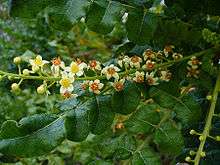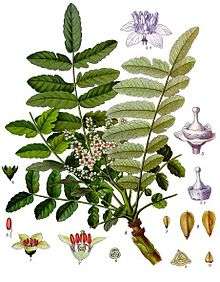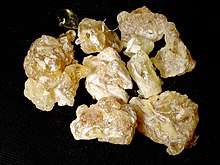Boswellia sacra
Boswellia sacra (commonly known as frankincense or olibanum-tree)[5] is a tree in the Burseraceae family. It is the primary tree in the genus Boswellia from which frankincense, a resinous dried sap, is harvested. It is native to the Arabian Peninsula (Oman, Yemen), and northeastern Africa (Somalia).[5]
| Boswellia sacra | |
|---|---|
 | |
| Scientific classification | |
| Kingdom: | Plantae |
| Clade: | Tracheophytes |
| Clade: | Angiosperms |
| Clade: | Eudicots |
| Clade: | Rosids |
| Order: | Sapindales |
| Family: | Burseraceae |
| Genus: | Boswellia |
| Species: | B. sacra |
| Binomial name | |
| Boswellia sacra | |
| Synonyms[4] | |
Description
This species of Boswellia is a small deciduous tree, which reaches a height of 2 to 8 m (6 ft 7 in to 26 ft 3 in), with one or more trunks. Its bark has the texture of paper and can be removed easily. It has compound leaves and an odd number of leaflets, which grow opposite to one another along its branches. Its tiny flowers, a yellowish white, are gathered in axillary clusters composed of five petals, ten stamens and a cup with five teeth. The fruit is a capsule about 1 cm (0.39 in) long. The new leaves are covered with a fine down.
Individual trees growing on steep slopes tend to develop some buttressing that extends from the roots up into the base of the stem. This forms a sort of cushion that adheres to the rock and ensures a certain stability.
Occurrence and habitat
B. sacra tolerates the most critical situations and often grows on rocky slopes and ravines, up to an elevation of 1,200 m (3,900 ft), mostly in calcareous soil. Boswellia sacra is abundant in Oman in arid woodland, on the steep, precariously eroding slopes in the mountains of Dhofar, but it is most prevalent in northern Somalia.[1]
In Somalia, frankincense is harvested in the Sanaag and Bari regions: mountains lying at the northwest of Erigavo; El Afweyn District; Cal Madow mountain range, a westerly escarpment that runs parallel to the coast; Cal Miskeed, a middle segment of the frankincense-growing escarpment; Karkaar mountains or eastern escarpment, which lies at the eastern fringe of the frankinscence escarpment.[6][7]
In Dhofar, Oman, frankincense species grow North of Salalah and were traded in the ancient coastal city of Sumhuram, now Khor Rori.
Resin
The trees start producing resin when they are about 8 to 10 years old.[8]
The resin is extracted by making a small, shallow incision on the trunk or branches of the tree or by removing a portion of the crust of it. The resin is drained as a milky substance that coagulates in contact with air and is collected by hand.
Growing conditions vary significantly, affecting both tree development and resin produced. Trees in the narrow fog-laden zone where the desert meets Dhofar mountain range, a region known as the Nejd, grow extremely slowly and produce very high quality resin in large, white clumps. Omanis and other Gulf State Arabs consider this to be superior to all other resins produced in North and Northeast Africa, India, and Asia, and it is priced accordingly.
Threats
Recent arguing about the frankincense tree populations growth of prevalence rate. There are many initiatives taken from owners of the lands, and organizations like the international banks have invested in harvesting new trees and making protection tools for the regions where the trees are mostly growing. It has helped in the increase of the production of the resin.
Gallery
 Boswellia sacra illustration
Boswellia sacra illustration Boswellia sacra inside Biosphere 2
Boswellia sacra inside Biosphere 2 Frankincense from Yemen
Frankincense from Yemen
References
- Assessor: Thulin, M. (1998). "Boswellia sacra". IUCN Red List of Threatened Species. 1998. Retrieved November 24, 2012.
- "Name - Boswellia sacra Flueck". Tropicos. Saint Louis, Missouri: Missouri Botanical Garden. Retrieved November 25, 2012.
- Boswellia sacra was originally described and published in Lehrbuch der Pharmakognosie des Pflanzenreiches. 31. 1867. (as cited in Flückiger & Hanbury's Pharmacographia). Freidrich A. Flückiger; Daniel Hanbury, F.R.S. (1874). Pharmacographia, a history of the principal drugs of vegetable origin, met with in Great Britain and British India. London: Macmilan and Co. p. 120. Retrieved November 24, 2012.
Lehrbuch der pharmakognosie Flückiger Boswellia sacra.
- "TPL, treatment of Boswellia sacra Flueck.". The Plant List; Version 1. (published on the internet). Royal Botanic Gardens, Kew and Missouri Botanical Garden. 2010. Retrieved November 24, 2012.
- "Boswellia sacra". Germplasm Resources Information Network (GRIN). Agricultural Research Service (ARS), United States Department of Agriculture (USDA). Retrieved November 24, 2012.
- Programme, author, War-Torn Societies Project International, Somali (2001). Rebuilding Somalia : issues and possibilities for Puntland. London: HAAN. p. 124. ISBN 1874209049.
- Patinkin, Jason (25 December 2016). "World's last wild frankincense forests are under threat". Yahoo Finance. Associated Press. Retrieved 25 December 2016.
- "Omani World Heritage Sites". www.omanwhs.gov.om. Archived from the original on 2008-10-12. Retrieved 2009-01-14.
